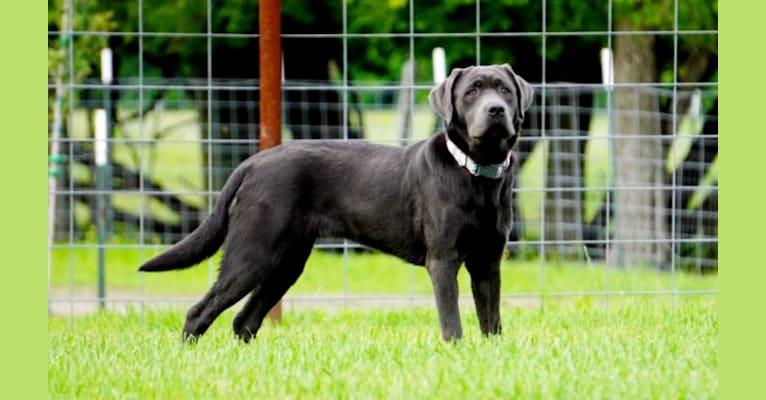Banjo inherited one copy of the variant we tested
No Dogs Available
It looks like you don’t have any dogs on your account yet. Activate a kit now!
No bio has been provided yet
This dog has been viewed and been given 0 wags
Registration
American Kennel Club
(AKC):
SS20331002
Start a conversation! Message this dog’s owner.
Explore
Health Summary
Banjo inherited one variant that you should learn more about.
Exercise-Induced Collapse, EIC
What does this result mean?
This variant should not impact Banjo’s health. This variant is inherited in an autosomal recessive manner, meaning that a dog needs two copies of the variant to show signs of this condition. Banjo is unlikely to develop this condition due to this variant because she only has one copy of the variant.
Impact on Breeding
Your dog carries this variant and will pass it on to ~50% of her offspring. You can email breeders@embarkvet.com to discuss with a genetic counselor how the genotype results should be applied to a breeding program.
What is Exercise-Induced Collapse, EIC?
EIC has been linked to a mutation in the DNM1 gene, which codes for the protein dynamin. In the neuron, dynamin trucks neurotransmitter-filled vesicles from the cell body, where they are generated, to the dendrites. It is hypothesized in dogs affected with EIC, the mutation in DNM1 disrupts efficient neurotransmitter release, leading to a cessation in signalling and EIC.
Breed-Relevant Genetic Conditions
Canine Elliptocytosis (SPTB Exon 30)
Identified in Labrador Retrievers
Variant not detected
Pyruvate Kinase Deficiency (PKLR Exon 7, Labrador Retriever Variant)
Identified in Labrador Retrievers
Variant not detected
Progressive Retinal Atrophy, prcd (PRCD Exon 1)
Identified in Labrador Retrievers
Variant not detected
Golden Retriever Progressive Retinal Atrophy 2, GR-PRA2 (TTC8)
Identified in Labrador Retrievers
Variant not detected
Progressive Retinal Atrophy, crd4/cord1 (RPGRIP1)
Identified in Labrador Retrievers
Variant not detected
Day Blindness (CNGA3 Exon 7, Labrador Retriever Variant)
Identified in Labrador Retrievers
Variant not detected
Macular Corneal Dystrophy, MCD (CHST6)
Identified in Labrador Retrievers
Variant not detected
Urate Kidney & Bladder Stones (SLC2A9)
Identified in Labrador Retrievers
Variant not detected
Alexander Disease (GFAP)
Identified in Labrador Retrievers
Variant not detected
Degenerative Myelopathy, DM (SOD1A)
Identified in Labrador Retrievers
Variant not detected
Narcolepsy (HCRTR2 Intron 6, Labrador Retriever Variant)
Identified in Labrador Retrievers
Variant not detected
Ullrich-like Congenital Muscular Dystrophy (COL6A3 Exon 10, Labrador Retriever Variant)
Identified in Labrador Retrievers
Variant not detected
Centronuclear Myopathy, CNM (PTPLA)
Identified in Labrador Retrievers
Variant not detected
X-Linked Myotubular Myopathy (MTM1, Labrador Retriever Variant)
Identified in Labrador Retrievers
Variant not detected
Congenital Myasthenic Syndrome, CMS (COLQ, Labrador Retriever Variant)
Identified in Labrador Retrievers
Variant not detected
Hereditary Nasal Parakeratosis, HNPK (SUV39H2)
Identified in Labrador Retrievers
Variant not detected
Skeletal Dysplasia 2, SD2 (COL11A2, Labrador Retriever Variant)
Identified in Labrador Retrievers
Variant not detected
Additional Genetic Conditions
Explore
What is a linkage test?
DNA sequences that are close together on a chromosome tend to be inherited together. Because of this, we can use genetic variation surrounding a specific variant (i.e. "linked" to it) to infer the presence or absence of a variant that is associated with a health condition or trait.
Linkage tests are not as predictive of your dog’s true genotype as direct assays, which we use on most other genetic conditions we test for.
Traits
Explore the genetics behind your dog’s appearance and size.
No Result
For every test, we run multiple assays to ensure the accuracy of the results we deliver. For your dog, one or more of these produced inconclusive or low confident results. Therefore, we are not able to provide you with a result at this time.
Coat Color
No Result
For every test, we run multiple assays to ensure the accuracy of the results we deliver. For your dog, one or more of these produced inconclusive or low confident results. Therefore, we are not able to provide you with a result at this time.
Other Coat Traits
No Result
For every test, we run multiple assays to ensure the accuracy of the results we deliver. For your dog, one or more of these produced inconclusive or low confident results. Therefore, we are not able to provide you with a result at this time.
Other Body Features
No Result
For every test, we run multiple assays to ensure the accuracy of the results we deliver. For your dog, one or more of these produced inconclusive or low confident results. Therefore, we are not able to provide you with a result at this time.
Body Size
No Result
For every test, we run multiple assays to ensure the accuracy of the results we deliver. For your dog, one or more of these produced inconclusive or low confident results. Therefore, we are not able to provide you with a result at this time.














